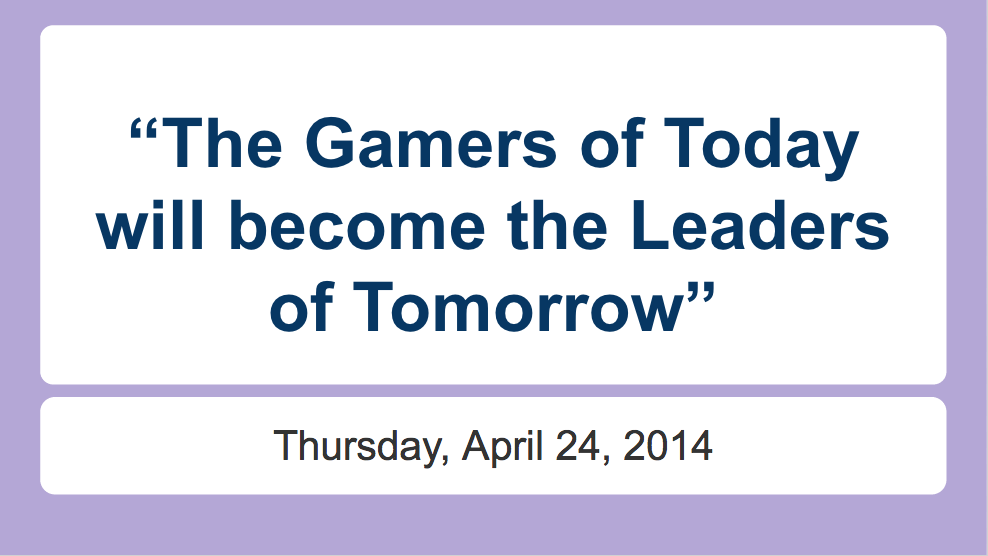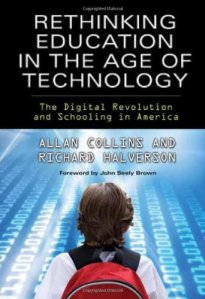Reading:
Gee, James. (2009) Good Video Games and Good Learning.
Klopfer, Eric; Osterweil, Scot; Salen, Katie. (2009). Moving Learning Games Forward: Obstacles, Opportunities, and Openness. Report from the Education Arcade, MIT.
Squire, Kurt. (2006). From Content to Context: Videogames as Designed Experience, Educational Researcher. 35(8) 19-29.
Video games and learning is something I have thought a lot about (and apparently blogged a lot about! here, here, here, here, here, here, here, and here) in the last 4 years since I began a project integrating SimCity into my 7th grade science classroom. I participated in the Games and Learning MOOC that Squire and Steinkuehler taught last fall, Reality is Broken by Jane McGonigal is a favorite, and this spring I finally got a chance to present on the topic of video games and learning to parents and a few teachers at my school. This week’s readings built on this foundation and affirmed a lot that I already believe, but I want to add an analogy that I think is helpful in terms of why games belong in education and one aspect that I think was missed.
First, though, I feel like I need to come clean and admit that I’m a gamer. Whenever I talk about games in education, I almost always preface it with “I’m not really a gamer.” I say it for two reasons. One, because I do regularly play major video games like WoW or Call of Duty, so my gaming does not align with what people stereotypically associate with the label “gamer.” Two, if I did identify myself as a gamer, it might prevent honest conversations with teachers or parents who are skeptical or negative about games, whereas presenting myself as a non-gamer allies me with them. I think this gets at the deep attitudinal barriers that Klopfer et al. (2009) refer to. But when I read the descriptions of the range of what is considered gaming, it’s me. My earliest memories include being allowed to “pick tiles” for my mom’s Scrabble game, I got Yahtzee with 3’s when I was 3 (very exciting), finally beating my older brother at Monopoly (which he contested, of course), and staying up very late playing Tetris against my cousin with our linked Gameboys. I spend and have spent a lot of time playing games; I’m a gamer.
One way that I find is helpful to address the deep skepticism and negative reaction to video games in the classroom is through an analogy. (It is not my own: I credit it completely to the director of educational technology that I worked with at OES, Brad Baugher.) While it’s an easy comparison to talk about how video games are like athletics, he took it one step further. He argued that the way video games are played right now is a lot like pick up games: informal, unsupervised, unregulated, ad hoc, and exclusionary. We believe (and spend a lot of money) on incorporating sports into schools because we see that they teach valuable life skills like grit, persistence, cooperation, and inclusion, and we employ coaches to facilitate this. Incorporating video games into the classroom is a lot like bringing them into a space where teachers can facilitate the game play, such as incorporating reflection on the experience.
The aspect that I think was missed, particularly in the Education Arcade’s report, is involving students in the creation of games. Klopfer et al. (2009) mention this in the example of Gamestar Mechanic, but not really elaborated on: “The Gamestar Mechanic team argues that by participating in and understanding the interactions of multiple complex systems, they are developing skills that are crucial for an increasing collaborative, networked, and high tech society.” This meta-awareness is crucial, and this is what I think needs to be used to create a sense of urgency amongst educators. In my experience with SimCity, and here I will make an unresearched generalization from my anecdotal though professional experience, students rarely asked why the games were designed they way they were. Boys were much more likely to prod the limits of the game and test cheat codes but without asking fundamental questions about the assumptions of the games, whereas girls were more likely to accept the gameplay as they were and seek to optimize their play within the rules, but also without questioning the game itself. I think this says a lot about how gender plays out in the game of school in general. Engaging students in game design will improve their understanding that games are artifacts designed by people who have ideologies, beliefs, and values, in the same way that learning to create movies or use photoshop helps them understand the media they see. By extension, students who learn to identify the rules and ideologies of a game can ultimately learn to question how and why “real life” societies are governed by rules and ideologies. I, perhaps optimistically, see intentional and reflective game play as an exploration and understanding of who we are and the world we live in.





You must be logged in to post a comment.